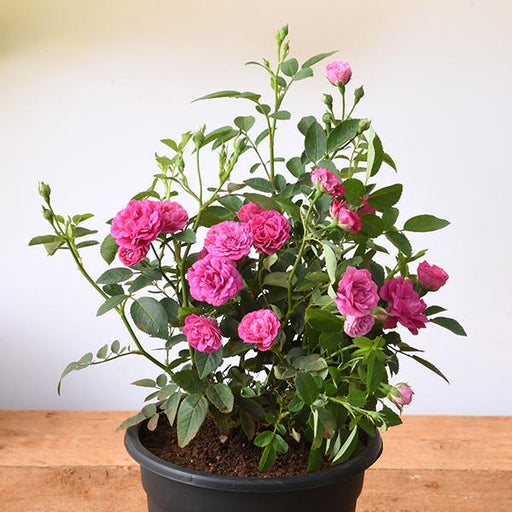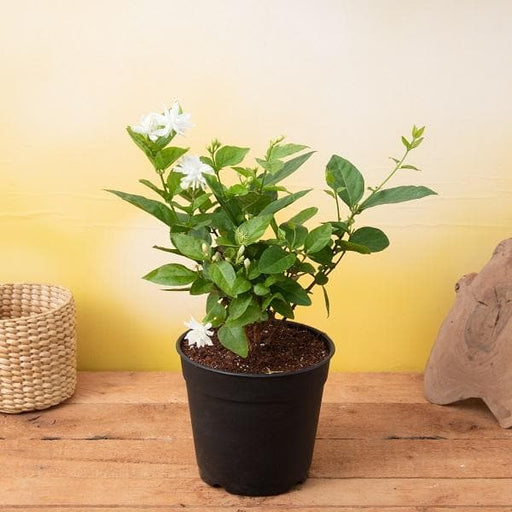
Caesalpinia spinosa - Plant
(MRP Inclusive of all taxes)
- Shipping ₹79 for entire order
- Dispatch in 7 days
- Country of origin: India

(MRP Inclusive of all taxes)
 Save 29%
Save 29%
Air Purifier Money Plant with Pot The Air Purifier Money Plant, also known as Pothos or Epipremnum aureum, is a stunning indoor plant that...
View full details
 Save up to 15%
Save up to 15%
Peace Lily, Spathiphyllum - Plant The Peace Lily, scientifically known as Spathiphyllum, is a stunning houseplant celebrated for its elegant white...
View full details
 Save 25%
Save 25%
Jasminum sambac, Mogra, Arabian Jasmine - Plant Jasminum sambac, commonly known as Mogra or Arabian Jasmine, is a fragrant flowering plant...
View full details
 Save 18%
Save 18%
Combo Constituents Includes the Parijat Tree (Night-Flowering Jasmine), a culturally significant plant with fragrant flowers. Description The Pari...
View full details
 Save 25%
Save 25%
Miniature Rose, Button Rose (Any Color) - Plant The Miniature Rose, also known as the Button Rose, is a charming and compact flowering plant that ...
View full details Save 25%
Save 25%
Damascus Rose, Scented Rose (Any Color) - Plant The Damascus Rose, also known as Rosa damascena, is a timeless symbol of beauty and romanc...
View full details
 Save 17%
Save 17%
Beautiful Fragrant Mogra, Arabian Jasmine Plant with Pot The Beautiful Fragrant Mogra, also known as Arabian Jasmine (Jasminum sambac), is...
View full details Save 15%
Save 15%
Pack of Vermicompost and Neem Cake for House Plants Transform your indoor garden with our premium Pack of Vermicompost and Neem Cake, spec...
View full details
Pack of Plant Growth and Flower Boosters Unlock the full potential of your garden with our Pack of Plant Growth and Flower Boosters! This ...
View full details Save 38%
Save 38%
Combo of Jeevamrut and Neem Raksha for Easy Growth and Protection of Houseplants Transform your indoor garden with our exclusive combo of ...
View full details Save 22%
Save 22%
Plant Nutrients Kit (Pack of 16) for a Healthy Garden Transform your garden into a lush paradise with our Plant Nutrients Kit, featuring 1...
View full details Save 16%
Save 16%
Combo of Top Plant Fertilizers Elevate your gardening game with our exclusive Combo of Top Plant Fertilizers, featuring two bags of premiu...
View full details Save 24%
Save 24%
Pack of 4 Additives to Make Soil Healthy and Nutrient Rich Transform your garden into a thriving ecosystem with our Pack of 4 Additives de...
View full details Save 30%
Save 30%
Transform your gardening experience with our premium Combo of Perlite and Vermiculite. This unique blend is designed to enhance soil aeration and ...
View full details Save 27%
Save 27%
Combo of 2 Vermicompost and Cocopeat - Enrich Your Soil Naturally! Transform your garden into a thriving ecosystem with our Combo of 2 Ver...
View full details
 Save 35%
Save 35%
Best 6 Plants for Perfect Indoor Garden Transform your living space into a lush oasis with our curated collection of the Best 6 Plants for a...
View full details
 Save up to 50%
Save up to 50%
Mini Succulent Garden Pack Transform your space with our Mini Succulent Garden Pack, featuring a delightful collection of 4 any variety beautiful s...
View full details
 Save 30%
Save 30%
5 Best Fragrant Plants Transform your garden or indoor space into a fragrant paradise with our curated selection of the 5 Best Fragrant Plants. Th...
View full details
 Save 24%
Save 24%
Set of 2 Bonsai Looking Grafted Adeniums Transform your indoor or outdoor space with our exquisite Set of 2 Bonsai Looking Grafted Adenium...
View full details Save 45%
Save 45%
Top 4 Die Hard Succulents Pack Transform your indoor or outdoor space with our Top 4 Die Hard Succulents Pack, featuring a curated selecti...
View full details
 Save 30%
Save 30%
5 Best Indoor Plants Pack Transform your living space into a lush oasis with our '5 Best Indoor Plants Pack.' This carefully curated collection fe...
View full details
 Save 25%
Save 25%
Set of 4 Evergreen Air Purifier Plant Pack Transform your indoor space into a lush, green oasis with our Set of 4 Evergreen Air Purifier Pla...
View full details| SrNo | Item Name |
|---|---|
| 1 | Caesalpinia spinosa - Plant |
Caesalpinia spinosa, commonly known as Tara or Peruvian Tara, is a remarkable leguminous plant native to the arid regions of South America. This hardy shrub is celebrated for its striking yellow flowers and unique seed pods, which are not only visually appealing but also serve various practical purposes. With its ability to thrive in poor soils and withstand drought, Caesalpinia spinosa is an excellent choice for sustainable landscaping and erosion control.
What makes Caesalpinia spinosa special is its multifaceted utility. The seeds are rich in tannins, making them valuable in the leather industry, while the plant itself is used in traditional medicine for its anti-inflammatory properties. Its resilience and adaptability to harsh environments contribute to its growing popularity among eco-conscious gardeners and landscapers.
One of the standout features of Caesalpinia spinosa is its nitrogen-fixing ability, which enhances soil fertility and promotes biodiversity. This plant not only beautifies landscapes but also plays a crucial role in improving the ecosystem, making it a sustainable choice for gardeners looking to make a positive environmental impact.
Caesalpinia spinosa plays a vital role in combating soil erosion and improving soil health. Its deep root system helps stabilize the soil, while its nitrogen-fixing properties enhance nutrient availability for surrounding plants. By incorporating this plant into your garden, you contribute to a healthier ecosystem and promote biodiversity.
If you’re looking for a plant that’s not just a pretty face, look no further than Caesalpinia spinosa. This spunky little tree offers a buffet of benefits, from its stunning yellow flowers to its ability to thrive in arid conditions. It’s like the overachiever of the plant world, providing shade, beauty, and even medicinal properties. Who knew a tree could be so multi-talented?
Caring for Caesalpinia spinosa is like having a pet rock—low maintenance but still requires some love. This drought-tolerant diva prefers well-drained soil and plenty of sunshine. Just remember, it’s not a fan of soggy feet, so keep the watering can at bay. With a little TLC, you’ll have a thriving tree that’s the envy of your garden.
This tree isn’t just a pretty sight; it’s a jack-of-all-trades! From ornamental landscaping to erosion control, Caesalpinia spinosa knows how to strut its stuff. Its pods can even be used in traditional medicine. Talk about versatility! Whether you want to impress your neighbors or just need a reliable plant, this tree has got your back.
Want to spread the love? Propagating Caesalpinia spinosa is easier than pie—just grab some seeds and get to work! Soak them overnight, plant them in well-draining soil, and watch as they sprout into little green wonders. It’s like a magic show, but with plants. Soon, you’ll have a mini forest of these beauties to call your own.
Every rose has its thorn, and every tree has its pests. But fear not! Caesalpinia spinosa is relatively pest-resistant, making it the cool kid on the block. Occasional aphids or caterpillars might try to crash the party, but a little neem oil or insecticidal soap will send them packing. Keep your tree healthy, and it’ll keep the pests at bay.
If you think Caesalpinia spinosa is picky about its soil, think again! This tree thrives in poor, well-drained soils, making it the ultimate low-maintenance plant. It’s like that friend who’s happy with a picnic on the grass instead of a fancy restaurant. Just ensure it’s not waterlogged, and you’re golden!
This tree is a sun-worshipper, thriving in warm, dry climates. If you live in a place where the sun shines brighter than your future, Caesalpinia spinosa will be your best friend. It’s like the ultimate beach buddy, soaking up the rays while providing shade for you to relax under. Just don’t expect it to handle frost; it’s not a fan of the cold!
Standing tall and proud, Caesalpinia spinosa can reach heights of up to 20 feet. It’s like the gentle giant of the garden, offering shade and beauty without being overbearing. Perfect for those who want a tree that makes a statement without taking over the entire yard. Just imagine the Instagram photos!
With its vibrant yellow flowers, Caesalpinia spinosa is like the life of the garden party. These blooms attract pollinators like bees and butterflies, making your yard a buzzing hotspot. It’s like throwing a flower party where everyone’s invited! Plus, the flowers are a feast for the eyes, adding a splash of color to any landscape.
The wood of Caesalpinia spinosa is not just for show; it’s durable and often used in crafts and furniture. Think of it as the lumberjack of the plant world—strong, sturdy, and ready to take on any project. So, if you’re into DIY, this tree could be your next best friend. Just don’t forget to thank it for its hard work!
Looking to jazz up your landscape? Caesalpinia spinosa is the perfect addition! Its unique shape and stunning flowers make it a standout choice for gardens, parks, and even urban settings. It’s like the stylish accessory that completes your outfit—elevating your outdoor space to new heights of fabulousness. Get ready for compliments!
This tree isn’t just a pretty face; it has a history of medicinal use too! Traditionally, various parts of Caesalpinia spinosa have been used for their health benefits, from treating inflammation to aiding digestion. It’s like having a natural pharmacy right in your backyard. Just remember, while it’s great for your garden, consult a professional before using it for health purposes!
Caesalpinia spinosa, also known as the Tara tree, is a leguminous plant native to South America. It’s famous for its spiky pods and vibrant yellow flowers. Think of it as nature’s way of saying, “I’m tough but fabulous!” Perfect for adding a splash of color and character to your garden.
Caring for Caesalpinia spinosa is like nurturing a diva; it loves well-drained soil and plenty of sunlight. Water it moderately, and let it bask in the sun. Just remember, too much water is like too much drama—best avoided! With the right care, it’ll reward you with stunning blooms.
Absolutely! Caesalpinia spinosa is the ultimate water-saving superstar. Once established, it can thrive on minimal water, making it perfect for those who prefer a low-maintenance garden. It’s like the plant equivalent of a minimalist—less fuss, more fabulousness!
Caesalpinia spinosa is not just a pretty face; it’s a multitasker! Its pods are used to produce tara gum, a thickening agent in food and cosmetics. Plus, it’s great for erosion control and adds a touch of exotic flair to landscapes. Talk about a plant with a résumé!
Fear not! Caesalpinia spinosa is not known to be invasive. It knows its boundaries and prefers to stay in its lane. However, like any good neighbor, it appreciates a little space to grow and shine without crashing the party of other plants.
While Caesalpinia spinosa prefers the great outdoors, you can try growing it indoors if you have a sunny spot. Just remember, it’s a plant that loves to stretch its legs, so give it a spacious pot and plenty of light. Indoor gardening just got a little more exotic!
Caesalpinia spinosa typically blooms in late spring to summer, showcasing its stunning yellow flowers. It’s like the plant version of a summer festival—bright, cheerful, and impossible to ignore! Get ready to enjoy a floral fiesta in your garden when it decides to show off.
Caesalpinia spinosa can reach heights of 10 to 20 feet, depending on its environment. It’s like the tall friend in your group—always standing out! With its impressive stature, it can serve as a striking focal point in your garden or landscape.
Caesalpinia spinosa thrives in warm, dry climates, so if you live in a tropical paradise or a sunny desert, you’re in luck! However, it’s not a fan of frost, so if you’re in a chilly zone, consider it a summer fling rather than a long-term commitment.
Caesalpinia spinosa is a moderate grower, typically adding a few feet each year. It’s not a speed demon, but it knows how to take its time and still look fabulous. Patience is key; soon enough, you’ll have a stunning specimen to admire!
Yes, you can propagate Caesalpinia spinosa through seeds or cuttings! Just remember to soak the seeds overnight for better germination. It’s like giving them a little spa treatment before they embark on their journey to becoming fabulous plants. Get ready to share the love!
Caesalpinia spinosa is generally pest-resistant, but watch out for aphids and spider mites. They can be pesky party crashers! A good spray of water or insecticidal soap can send them packing. Keep your plant healthy, and it’ll continue to shine without unwanted guests.